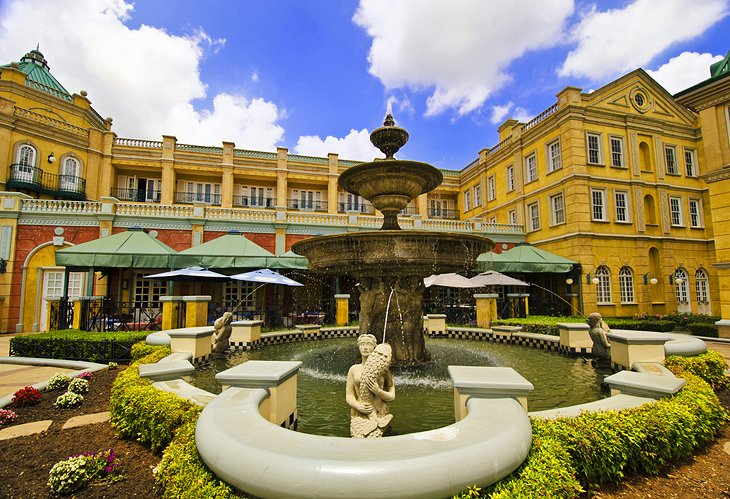The Best Guide To Johannesburg North Attractions
Table of ContentsJohannesburg North Attractions Things To Know Before You Get ThisThe 8-Second Trick For Johannesburg North AttractionsGetting The Johannesburg North Attractions To WorkThe Greatest Guide To Johannesburg North AttractionsSome Known Questions About Johannesburg North Attractions.The Facts About Johannesburg North Attractions Revealed
The city owes its location to the presence of a a lot more precious source: gold. The city grew on the side of the Witwatersrand Main Reef, a subterranean stratum of gold-bearing quartz-silica empire that arcs for numerous miles beneath the Highveld. The majority of the gold mines in the city ceased operation in the 1970s, yet in its day the Witwatersrand gold market accounted for greater than 40 percent of the world's yearly gold manufacturing.Johannesburg has a temperate climate. Summertime temperature levels average regarding 75 F (24 C); winter months temperature levels balance about 55 F (13 C) and only occasionally dip below freezing. The city enjoys concerning eight hours of sunlight each day in both wintertime and summer season. Rainfall averages concerning 28 inches (700 millimetres) per annum, but the total differs substantially from year to year.
What rain the city receives falls practically specifically in the summertime, typically in incredible late-afternoon electrical storms. Air air pollution presents a substantial issue, particularly in the cold weather, when thermal inversions impede the westward flow of air from the Indian Sea. Contamination is most extreme in the largely cleared up Black townships on the city's perimeter, where several citizens still depend on coal for gas.

The smart Trick of Johannesburg North Attractions That Nobody is Talking About
The balance of the city is occupied by whites. Holiday accommodation varies in character and high quality.
Physical growth, although somewhat restricted by transport, proceeded swiftly as migration to South Africa, and Johannesburg in certain, raised substantially. This problem was solved in the 1930s when the automobile was introduced in automation to South Africa. Autos were, essentially, constrained to the affluent, and allowed them to transfer to the north of the city and commute right into the centre.
A lot of poor suburbs were combined, with inadequate blacks and whites living together, although the well-off residential areas were typically booked for whites.
The estimated population of the region is 200,000, [] however the number of individuals staying in the central city on an informal basis is unknown, as numerous are prohibited immigrants. A lot of higher-income locals and white individuals have actually transferred to the north suburban areas and have been replaced by lower-income black individuals. The joblessness, education and learning, and age profiles of the area are all unknown, as a result of the problem of obtaining trusted details concerning the location.
What Does Johannesburg North Attractions Do?
Yeoville and Bellevue have a mix of home buildings and single residential units on little lots. The area is situated on a mountainous divide that runs from eastern to west.

Johannesburg Arena, a training ground for both the Golden Lions and Orlando Pirates, is nearby. The eastern suburbs of Johannesburg lie in the city's 7th [] and 9th [] regions. The location is additionally functionally integrated with East Rand boundary communities outside of the official this article limit of Johannesburg, such as Bedfordview and Edenvale (both part of Ekurhuleni Metropolitan Town).
Some Of Johannesburg North Attractions
The eastern residential areas are some of the earliest areas of Johannesburg, there are big communities of Jewish and various other European histories, the majority of the populace is English talking. There are three golf programs as well as a number of protected ridges with viewsites.
The location is mostly composed of old "matchbox" homes, or four-room residences developed by the federal government, that were built to supply economical lodging for black workers during discrimination. Soweto is an abbreviation, meaning "South Western Townships". Street after road in this location is lined with matchboxes; nevertheless, there are a couple of smaller areas where flourishing Sowetans have actually built houses that are a lot more similar in stature with those in more upscale suburban areas.
Hostels are one more popular physical feature of Soweto. Initially developed to house male migrant workers, several have actually been boosted as residences for couples and families. The N1 Western Bypass skirts the eastern boundary of Soweto. The residential area was not traditionally enabled to produce employment centres within the area, so mostly all of its residents are travelers to various other components of the city.
Examine This Report on Johannesburg North Attractions
The property areas in the northern suburban areas are generally formal, with no significant areas of informal housing, or real estate that does not have a long-term framework. This is a well-known area, there is a trend of land use change from household to commercial, check these guys out specifically along major arterial roadways and around established nodes.
The area is well linked to roadway networks, especially along the north-south axis created by the M1 and N1. Roads to the eastern and west are less well created, as there are no freeways taking a trip because instructions. In the direction of the north border of the city, the thickness of development reduces, leaving huge locations of undeveloped land around Midrand.
Some Known Details About Johannesburg North Attractions
The very first this link suburban area to the north of the internal city is Parktown, which is located on a hillside neglecting the central city and Hillbrow. It has numerous well-off locals and Edwardian-design manors, as well as the Education and Medical campuses of the University of the Witwatersrand. The huge concrete Charlotte Maxeke Johannesburg Academic Health Center controls the horizon of Parktown.